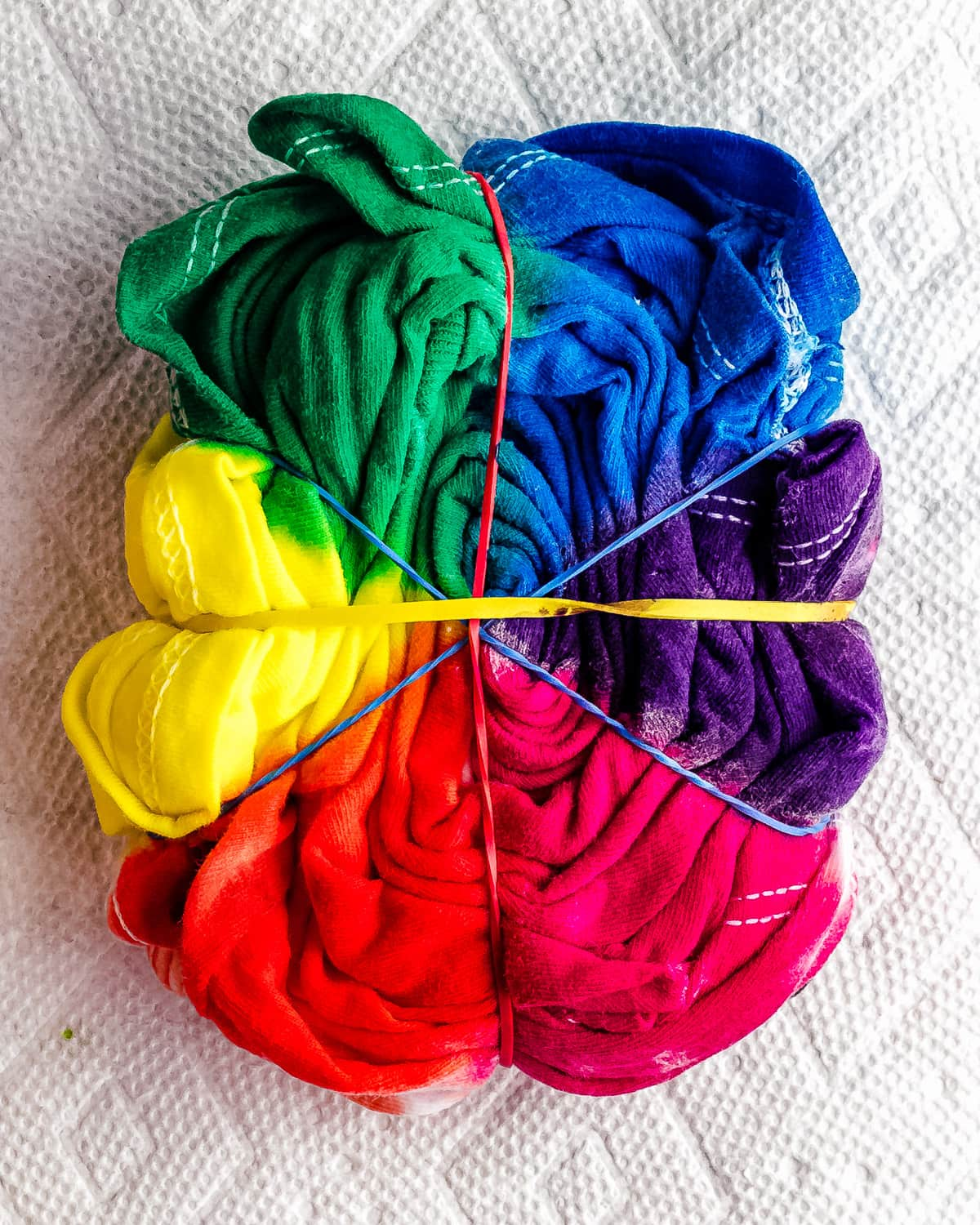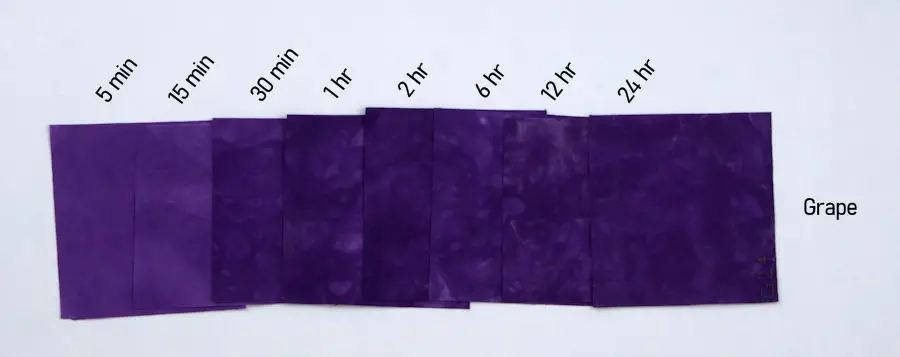If you leave tie dye too long, the risk is that the fabric can dry out, potentially causing uneven patches of color.
The Effects Of Leaving Tie Dye For An Extended Period
Leaving tie dye for an extended period can result in the dye settling into the fabric creases and potentially causing uneven patches of color. It is important to monitor the dyeing process to prevent the fabric from drying out and maintain the overall look of the design.
Leaving tie dye for an extended period can have various effects on the fabric and dye absorption. Let’s explore the two main effects that can occur:
Risk Of Fabric Damage And Color Bleeding:
- Leaving tie dye for too long can result in fabric damage, especially if the dye contains harsh chemicals. The longer the dye sits on the fabric, the higher the chance of the dye breaking down the fabric fibers.
- Additionally, prolonged exposure to moisture can lead to color bleeding. The dye may seep into areas where it wasn’t intended, causing undesirable color blending and smudging.
Possibility Of Uneven Dye Absorption:
- When tie dye is left for an extended period, there is a greater chance of uneven dye absorption. The dye needs a sufficient amount of time to react with the fabric fibers and bond with them. If the dye sits for too long, some areas may receive more dye than others, resulting in uneven color patterns.
- Uneven dye absorption can also occur if the fabric dries out during the dyeing process. If certain parts of the fabric dry out before the dye has fully absorbed, those areas may end up with lighter or no color at all.
It’s important to find the right balance between leaving tie dye for long enough to achieve vibrant colors and not letting it sit for too long, risking fabric damage and uneven dye absorption.

Credit: sarahmaker.com
How Long Is Too Long For Tie Dye To Sit?
Leaving tie dye for too long can cause the fabric to dry out and result in uneven color patches. It is recommended to let the dye sit for at least one hour, but overnight is even better for optimal results.
Factors That Determine The Optimal Dye Duration:
- Type of dye: Different dyes have different recommended durations for the best results. Some dyes may require longer soaking times to fully penetrate the fabric and achieve vibrant colors.
- Fabric type: The type of fabric you are dyeing can also impact the optimal dye duration. Natural fibers like cotton tend to absorb the dye more readily, while synthetic fibers may require longer soaking times for the dye to fully bond.
- Color intensity: If you are looking for a more intense and saturated color, you may choose to leave the tie-dye for a longer duration. However, keep in mind that excessive dyeing time can also result in color bleeding and the risk of the dye running or fading over time.
- Desired effect: The effect you are trying to achieve with your tie-dye design can also influence the optimal dye duration. For example, if you want a subtle and blended look, you may choose a shorter soaking time. On the other hand, if you want bold and distinct patterns, a longer soaking time may be necessary.
The Risk Of Drying Out The Fabric:
- Leaving tie-dye for too long can cause the fabric to dry out. This can result in uneven patches of dryness and affect the overall appearance of the design. It is essential to strike a balance between achieving the desired color intensity and ensuring that the fabric remains well-hydrated.
- Drying out the fabric can also make it challenging to rinse out the excess dye properly. This can lead to color bleeding and fading, even after washing.
Recommendations For The Ideal Dyeing Time:
- Start by following the instructions provided with your dye kit or the specific dye you are using. These instructions often include recommended soaking times to achieve the best results.
- As a general guideline, soaking tie-dye for at least one hour is recommended. However, to allow the dye enough time to fully penetrate the fabric, it is advisable to let it sit overnight or for a longer duration if possible.
- The longer the dye sits, the more time the dye molecules have to react with and stain the fabric fibers. This can result in deeper and longer-lasting colors. Just remember to ensure that the fabric remains damp throughout the dyeing process to avoid drying out.
- Experiment with different dye durations to find the perfect balance between color intensity and fabric hydration. Keep in mind that the optimal dye duration may vary depending on the factors mentioned above, such as dye type and fabric type.
- Once the desired dye duration is reached, thoroughly rinse out the excess dye with cold water until the water runs clear. Follow the dye kit instructions for washing and drying to set the colors and prevent color bleeding.
Remember to have fun and embrace the unique and unpredictable results that tie-dye can bring. Happy dyeing!
Avoiding Common Tie Dye Mistakes
Leaving tie dye on for too long can result in uneven patches of color and the risk of the fabric drying out. It’s recommended to let the dye soak for at least one hour, but overnight is even better for optimal results.
Tips To Prevent Leaving Tie Dye For Too Long:
- Check the recommended dyeing time: Different tie dye kits have different instructions. Make sure to read the kit’s instructions before starting the dyeing process to know the recommended dyeing time.
- Set a timer: To avoid leaving the tie dye on the fabric for too long, set a timer to remind yourself when it’s time to remove the fabric from the dye bath.
- Test a small swatch: Before dyeing your entire garment, try dyeing a small swatch of fabric to see how long it takes for the desired color intensity to be achieved. This will give you an idea of how long you should leave the dye on the fabric.
- Start with shorter dyeing times: If you’re unsure of how long to leave the dye on the fabric, start with a shorter dyeing time and gradually increase it if needed. It’s easier to add more dyeing time than to remove excess dye.
Best Practices For Achieving Vibrant And Even Colors:
- Use high-quality dyes: Invest in high-quality dyes that are known for producing vibrant and long-lasting colors. Cheaper dyes may result in dull or faded colors.
- Follow the dye’s instructions: Each dye brand may have its own specific instructions for achieving vibrant colors. Read and follow the instructions provided with the dye to ensure best results.
- Apply dye evenly: Make sure to apply the dye evenly to the fabric by using squeeze bottles, brushes, or other application methods. Uneven dye application can result in patchy or streaky colors.
- Use enough dye: To achieve vibrant colors, make sure to use enough dye. The fabric should be saturated with dye, but not overly soaked. Follow the dye’s instructions for the recommended amount of dye to use.
Proper Rinsing And Washing Techniques:
- Rinse with cold water: After the dyeing process, rinse the fabric with cold water to remove excess dye. Cold water helps to set the dye while preventing color bleeding.
- Gradually increase water temperature: Gradually increase the water temperature during the rinsing process to ensure thorough removal of excess dye. Start with cold water, then switch to lukewarm and finally to hot water.
- Wash separately: When washing tie-dyed garments for the first time, make sure to wash them separately from other clothes. This will prevent any potential color transfer.
- Use a mild detergent: Use a mild detergent specifically formulated for dyed fabrics. Harsh detergents can fade or strip away the dye, resulting in less vibrant colors.
- Air dry or tumble dry low: To preserve the vibrancy of tie-dyed colors, it’s best to air dry the garments or use the low setting on the dryer. High heat can cause colors to fade or bleed.
By following these tips and best practices, you can avoid leaving tie dye on fabric for too long and achieve vibrant and even colors in your tie-dye projects. Happy dyeing!
Frequently Asked Questions On What Happens If You Leave Tie Dye Too Long
Can I Let Tie-Dye Sit For 3 Days?
It is possible to let tie-dye sit for 3 days, but there is a risk of the fabric drying out and uneven patches of color.
Is It Bad To Leave Tie-Dye In Overnight?
Leaving tie-dye overnight is not recommended as it can cause uneven color and may dry out the fabric.
Does Tie-Dye Get Darker The Longer It Sits?
Tie-dye can get darker the longer it sits, but if left for too long, it can risk drying out and causing uneven patches of color.
Is It Better To Leave Tie-Dye Longer?
For the best results, it is recommended to leave tie-dye longer to allow the dye to react and stain the cotton fibers properly.
Q: Does Leaving Tie-Dye In Overnight Have Any Negative Effects?
A: Leaving tie-dye in overnight can lead to over saturation and potential color bleeding.
Conclusion
Leaving tie dye for too long can have negative consequences on the final outcome of your project. While it might be tempting to let the colors soak in for an extended period, there are a few things to keep in mind.
Firstly, if you leave tie dye for too long, it can lead to the fabric drying out, resulting in uneven patches of color. The longer the fabric sits, the more likely it is to settle into the creases, potentially disrupting the overall look.
Additionally, leaving tie dye for an excessive amount of time may result in dark patches of color that overpower the rest of the design. To avoid these issues, it’s best to follow the recommended instructions for letting tie dye sit and rinse it out in a timely manner.
By doing so, you’ll achieve vibrant and balanced results that you can proudly show off. Happy tie dyeing!


